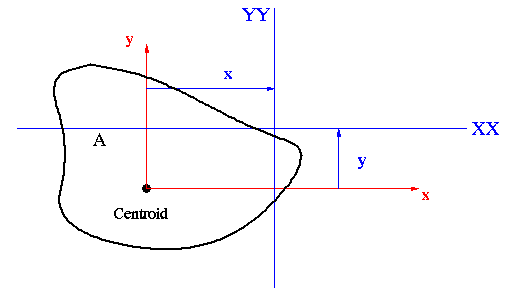Section II.1-2
Section
II.1-2 Parallel
Axis
Theorem
The parallel axis theorem is used for finding the rectangular moment of inertia
about an axis different from the centroidal axis of the section.
For the figure below the centroidal rectangular moments of inertia are
determined using


Using the parallel axis theorem, the moments of inertia about axes XX and YY
parallel to the centroidal axes x and y can be determined as

The parallel axis theorem is useful for finding the centroidal moments of
inertia of a
cross section composed of several simpler geometric parts as shown below.

The cross section is broken up into several simple shapes, the individual moments of
inertia are found, then the moments of inertia about the centroidal axes of the
entire section are found using
parallel axis theorem.
Usually the broken pieces are made up of rectangles. From mechanics of materials, the x and y moments of inertia of a rectangle are


EXAMPLE
PROBLEMS
- Example 1 Rectangular moments and
product of inertia of a symmetric section
- Example 2 Rectangular moments and
product of inertia of a symmetric skin-stringer section
- Example 3 Rectangular moments and
product of inertia of an unsymmetric skin-stringer section
- Example 4 Rectangular moments and
product of inertia of retangular box beam with 4 different size stiffeners
 To Section II.1-1
To Section II.1-1
 To Section II.1
To Section II.1
 To Index Page of
Pure Bending
To Index Page of
Pure Bending







 To Section II.1-1
To Section II.1-1